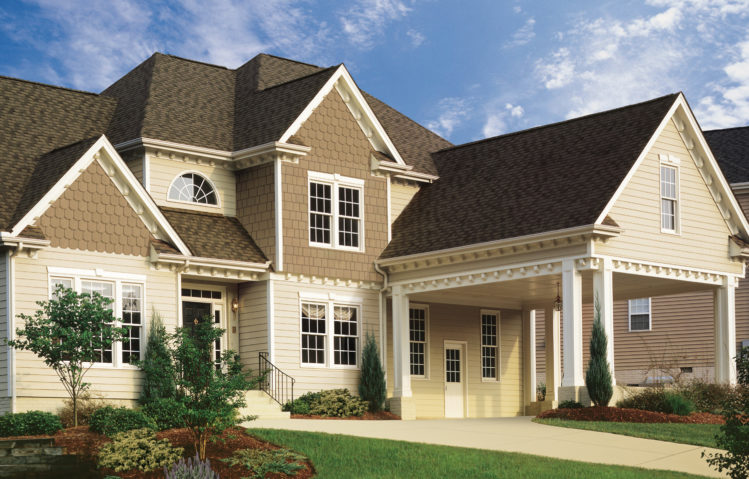
There are many exterior wall cladding materials that builders and homeowners can choose from when designing a new facade. Some materials are limited in terms of design, and others offer a range of colors and styles that provide an abundance of possibilities. Exterior wall cladding materials can also vary in terms of durability and how long they’ll last. Cost also becomes a factor when comparing exterior cladding materials side by side.
Not sure which type of exterior wall cladding material is right for your next project? This guide highlights nine of the most popular exterior cladding materials on the market. It’s important to consider the pros and cons – as well as the cost and maintenance – to determine the right cladding for your next building project.
1. Brick

Brick is a classic wall cladding material that can be seen in historic homes and new buildings alike. The benefits of brick are mostly summed up by its aesthetic appeal and physical strength. Brick has a warmth that brings immediate character to a home. It also proves to be quite sturdy and durable, and it offers good energy efficiency.
Brick also comes with drawbacks. Because of its particular style, there aren’t many design variations, so you’ll most likely be limited to a handful of color options to create a different look. Brick is also difficult to install and requires professional masonry expertise. Repairs can be costly. Brick usually breaks down to about $1-$3.50 per brick, which can add up quickly.
2. Vinyl

Considered one of the most affordable options for homeowners, vinyl offers a range of colors and styles to consider. It’s also easy to install. Exterior cladding materials made from vinyl typically cost $0.85 to $2.50 per square foot, which is appealing for builders on a budget.
With that said, vinyl is very vulnerable to sun damage, moisture, and general wear and tear. Since its core is plastic-based, vinyl is not considered an environmentally-friendly exterior cladding material. Vinyl is also flammable.
3. Wood

Exterior wood cladding materials are beautiful when maintained properly and add rich character to homes. Wood is a traditional material that offers lots of styles depending on how it’s milled.
The downside to wood cladding is that it requires an extreme amount of maintenance to keep up its original appearance. Wood is naturally vulnerable to pests, fire, moisture, and more, so issues pop up frequently and can compromise the integrity of exterior wall cladding materials. Wood can also be pricey, costing up to $5 per square foot.
4. Composite
There are lots of unique styles available with exterior wall cladding materials made from composite formulas like sawdust and scrap wood. Composite is a good alternative to natural wood cladding materials because it provides better durability.
However, composite cladding carries significant risk when it comes to safety, since these materials often feature adhesives that are high in VOCs. If it does catch fire, composite cladding can release harmful gasses into the air.
5. Stone

Stone is a traditional style that looks stately and sophisticated. Stone cladding can be found in a wide variety of color families, like brown, red, gray, and neutral hues. Stone offers better longevity than vinyl and wood. Limestone, sandstone, and marble are popular stone cladding choices.
The cost of stone cladding can be exponential because of its weight and the resources needed to construct it. Expect to pay anywhere from $10 to $40 per square foot for stone wall cladding with installation.
6. Fiber Cement

Fiber cement is an example of modern exterior cladding materials that combine beauty, strength, and affordability in one go. Fiber cement is relatively low-maintenance, and it is available in an abundance of colors and styles – including some styles that recreate the look of natural wood grain, stucco, and other classic designs.

There aren’t many drawbacks to fiber cement. Perhaps the main thing to be aware of is the fact that fiber cement can cost two to three times more than vinyl for installation, since professional installation is recommended. That said, you get what you pay for with fiber cement. The material lasts much longer with far less maintenance issues.
7. Aluminum
Aluminum is affordable and fire-resistant – two pros that many homeowners are looking for. Aluminum can be found in a lot of styles as well.
One of the biggest complaints with aluminum exterior wall cladding materials is that it can dent easily, especially with hail or everyday scrapes from fallen branches or debris. Some aluminum cladding can show signs of rust, too. All in all, aluminum is not very durable.
8. Steel
Steel is much stronger than other metal cladding, like aluminum, and it is known to last for several decades.
The drawbacks to steel are mostly due to cost and hassle. Steel can be heavy, so it’s often more difficult to install than other exterior wall cladding materials. It also has rust issues, so the material must be engineered in such a way to avoid this tendency.
9. Stucco

Stucco gives a distinct look that many homeowners love. Stucco is considered energy-efficient, and when installed properly, stucco can last several decades.
When stucco does show signs of age, usually in terms of water damage and flaky or crackling patches, the aesthetics of the home can be compromised quickly. Though you can pick up a bag of stucco mix for less than $10 a bag, you’ll need professional expertise to apply it correctly.
Choose The Best All Around Wall and Aesthetically Versatile Cladding Material: Fiber Cement
Modern exterior cladding materials can often imitate the look of stucco, wood, and other classic styles. Fiber cement is an excellent choice for getting a wide range of traditional styles without giving up the advantages of modern material strength.
When it comes to exterior cladding materials that offer superior strength and long-lasting beauty, fiber cement is the way to go. Contact Allura today to explore gorgeous fiber cement cladding options designed to last.




